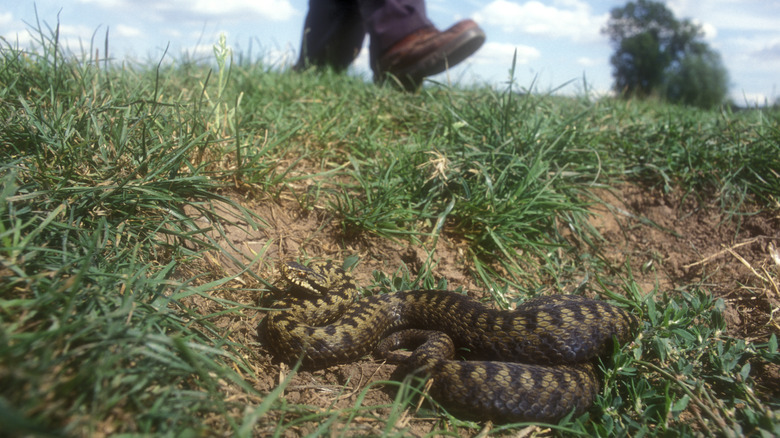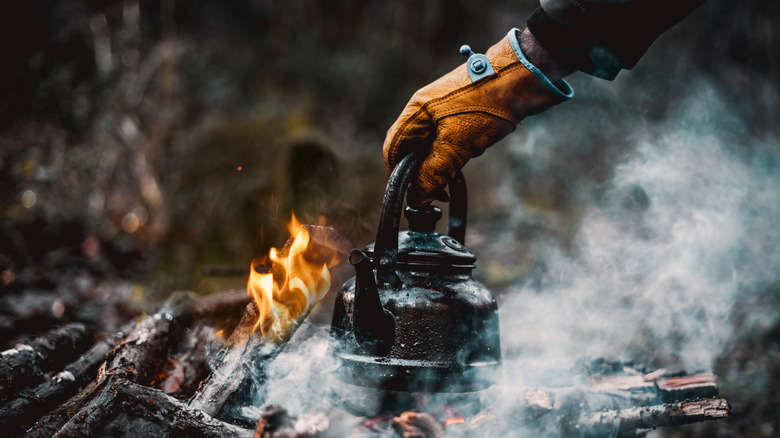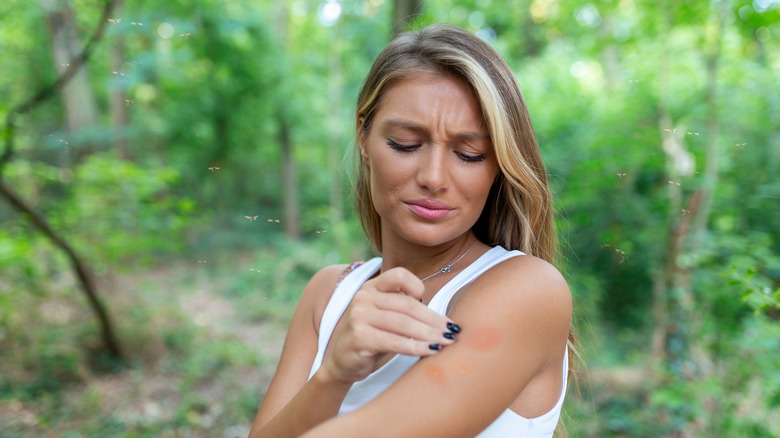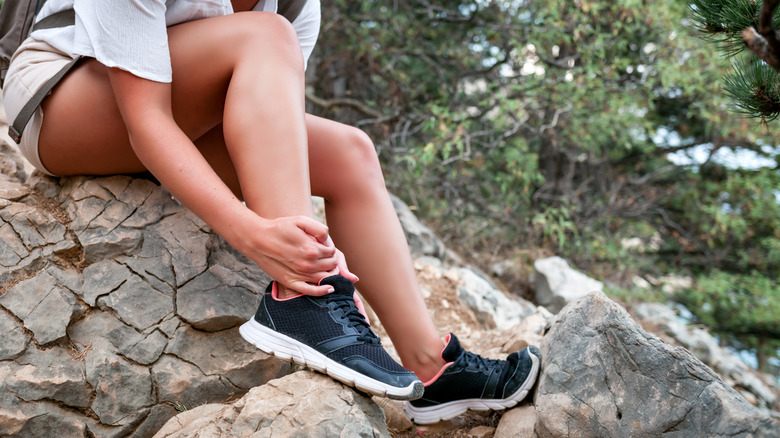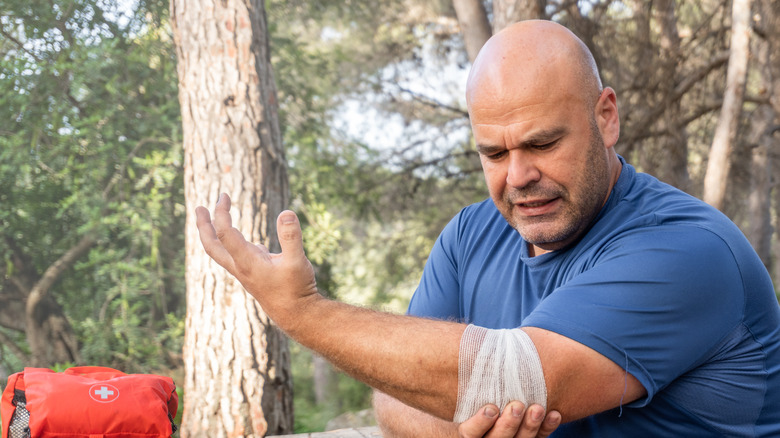What You Should Do If You Hurt Yourself In The Middle Of A Solo Hike
Going on a solo hike in the wilderness can be an exhilarating experience. It can be refreshing to spend a few hours alone as you challenge yourself on a rugged trail and enjoy the scenic vista surrounding you. It can also be risky to embark on a solo trip. Accidents and injuries can occur while you're enjoying your time on the trail, and it's important to have a plan to address any situations that may come up, especially if you're on your own when something takes place.
Most minor injuries can be treated during your hike with some forethought and a well-stocked first aid kit. Some basics for this kit include gauze, an ACE bandage, antibiotic cream, hydrocortisone cream, an oral antihistamine, adhesive bandages or medical tape, pain medication, sunscreen, moleskin, antiseptic wipes, a SAM splint, flexible ankle or knee brace, and an EpiPen, if necessary. Modify this list as you need to, depending on your situation and your own health history. Trekking poles will help you avoid injury, and they'll provide the support you need if you are hurt. Be sure to leave word with friends or family about your destination and route plan. Finally, it's imperative to bring a satellite device with you if you hike alone. Don't rely on your phone's battery and cell service if you need assistance. If one of the following situations escalates to the point where you need to be evacuated, a satellite device will provide you with a way to reach help.
Contact emergency services after a snake bite
One situation that a solo hiker should definitely prepare for is the possibility of a snake bite. As you make your way down the trail, you may run across a snake sunning itself on the rock that you just stepped across. If you are bitten, there are several things you should do. If at all possible, try to get a good look at or even a picture of the snake. While a rattlesnake can be identified by its rectangular head and narrow neck, other venomous snakes may be present on the trail as well. It's a good idea to treat the situation as an emergency and not simply hope that the snake wasn't venomous.
Contact emergency services with your satellite device and give them your location to see how you can receive medical treatment as soon as possible. Remove any tight-fitting jewelry or clothing that is near the site of the injury, because the area where you've been bitten will start to swell. Wash the wound with soap and water, then immobilize it if possible, using a sling if necessary. Never apply an ice pack or a tourniquet, as that will prevent healthy circulation to the affected area. Never try to suction out the venom, as it could promote infection. Studies have shown that an average person is more likely to be killed by a lightning strike than to die from a snake bite, so stay calm as you slowly make your way to meet medical services.
Know how to treat different types of burns
Cooking a meal over a campfire is part of the fun of camping, but improvising your heating source and tools can sometimes lead to an accident. Hastily grabbing a hot dish or getting your sleeve too close to a flame can lead to a painful and damaging burn. The first thing to do if this happens is to stay calm, take a deep breath, and examine the burn wound. If it looks red and feels painful, but there are no blisters, then it is a superficial burn that only affects the surface of the skin and can be treated with first aid supplies. Treat this type of injury by pouring cool water over the surface of the wound, then dress the area with an antibiotic cream that contains a pain relieving ingredient. Cover the wound with a bandage or a layer of gauze, and replace the dressing daily.
Partial- or full-thickness burns are more serious injuries that affect deeper layers of skin and require you to seek immediate medical attention. The symptoms of a partial-thickness burn include painful skin that has become blotchy and discolored where blisters have begun to form. A full-thickness burn is the most serious type of injury, where the wound feels numb but has turned gray and ashy. Seek medical help as soon as possible in these situations, and use your satellite device for assistance before the wounds become infected or the pain becomes unbearable.
Different treatment methods exist for various insect bites
An insect sting is unpleasant, but you can minimize its effect on your wellbeing and the rest of your trip. If you are stung, move away from where the hive might be located. Then look for evidence of the stinger, which appears like a small black dot in the area where you were stung. If it's a bee sting, remove the stinger as quickly as possible, as the tiny sac will continue to release venom for two or three minutes. Never use tweezers to remove it, as this could actually release more irritants into your skin. Instead, use a credit card or a knife to scrape the stinger out.
If you were stung by a different type of insect, such as a wasp or hornet, there typically isn't a stinger left inside the wound, but multiple stings can make this kind of injury very painful. If you have access to ice or even snow, apply it to the injured site to reduce inflammation and swelling. Clean the area with soap and water, and apply a hydrocortisone cream to help diminish the painful side effects. Take an antihistamine, such as Benadryl, to reduce the uncomfortable swelling and itching. However, if you know you are prone to allergic reactions to insect bites, use your EpiPen as necessary to prevent further complications, such as difficulty breathing, swallowing, or dizziness. If symptoms such as these start to occur, it's best to notify medical services with your satellite device that you need attention.
After a sprain or fracture, immobilize the affected area
When you hike downhill, you're placing eight times your body weight on each step you take. This type of force can knock you off balance, resulting in injuries such as a sprained ankle or a fractured wrist. If you suffer an injury like this, you'll need to immobilize the affected area and determine whether you can hike to safety or will need to summon help. For an injured hand or wrist, stabilize the injury with an ACE bandage and then fashion a sling with a piece of clothing. If you think you may have a fracture, use a SAM splint to keep the bone stable.
If you've injured your foot or ankle, resist the urge to remove your shoe as it may be difficult to replace once your foot begins to swell. Check your mobility by rotating your ankle and moving your toes. Immobilize your foot with the ankle brace you packed, or wrap it with an ACE bandage in a figure eight design. However, if it seems that the injury is due to a fracture, you'll need to stabilize the bone completely. Use a SAM splint to support the injury, or you can even wrap an uninflated mattress pad around the foot. Secure the pad with rope or tape, then slightly inflate the pad to create a cushion. If you're unable to evacuate the area on your own, use your satellite device to call for help, then remain calm, hydrated, and rested until they arrive.
If you cut yourself, elevate the injured area
Cuts and scrapes are a common part of hiking, as you brush against rocks and tree limbs, or when you prepare meals with a sharp knife. If you cut yourself on your hike, your first concern is to stop the bleeding. Apply pressure with a gauze bandage, and elevate the injured area above your heart. Once the bleeding has subsided, irrigate the wound using the spout of your clean drinking water, then clean the surrounding area with an antiseptic wipe. Apply antibiotic cream and a bandage, and pay close attention to any signs of infection over the next 24-48 hours. These symptoms can include skin that looks red and feels hot, and you might see red streaks appear alongside the wound. If these conditions develop, it's important to seek medical help as soon as possible.
It would also be necessary to end your hike and seek medical help if you experience a deeper cut that will not stop bleeding with a gauze pad. If the wound continues to bleed, apply pressure with an article of clothing and continue to elevate the injured area. Excessive movement will only accelerate the blood loss and make it difficult for you to communicate. Use your satellite device to inform emergency services about your location and medical condition, then try to rest and not panic. This type of scenario represents the key to a successful solo hike, which is to be prepared and always remain proactive throughout your trip.

